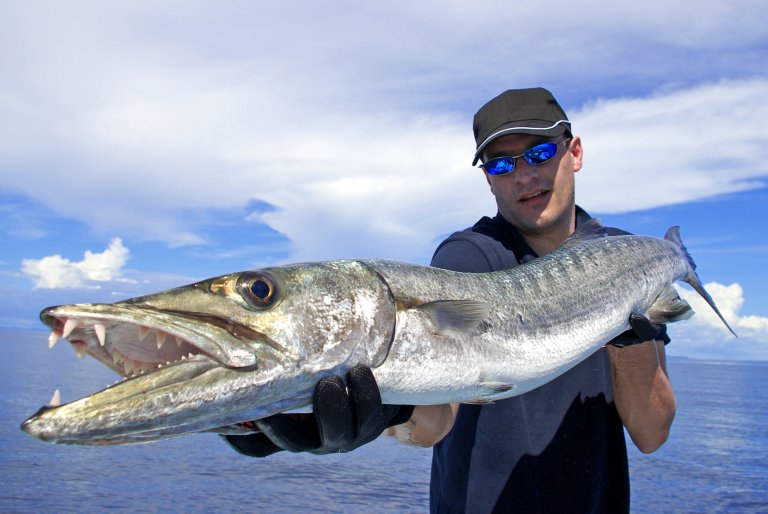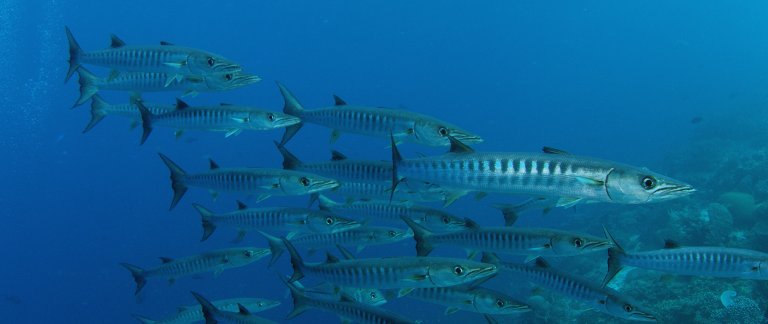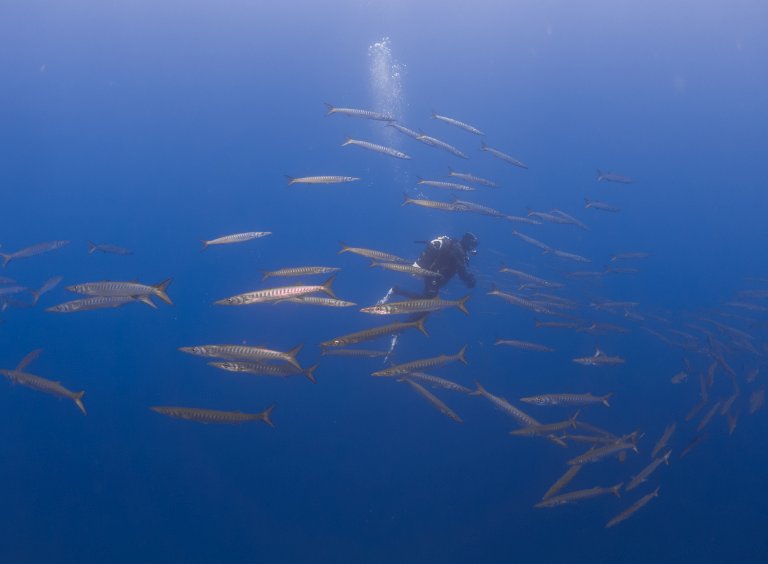Barracuda Profile
Throughout the tropical oceans of the world lurks a truly ferocious piscivore – one which has achieved worldwide notoriety for its role in Pixar’s Finding Nemo, in which it infamously gobbles up the titular character’s mother!
All but invisible until it’s too late, the barracuda or ‘cuda’ for short, is a fearsome and lightning fast fish-seeking missile, which packs a deadly arsenal of teeth.

Barracuda Facts Overview
| Habitat: | Shallow ocean habitats including shorelines, mangroves, coral reefs and around underwater structures. Can also be found in the open ocean. Inhabits depths no deeper 100 metres |
| Location: | Tropical and subtropical oceans worldwide from around 30° North to 30° South |
| Lifespan: | At least 14 years in larger species |
| Size: | 60cm – 165 cm (depending on species) |
| Weight: | 6kg – 24kg (depending on species) |
| Color: | Counter shaded. Generally blue, grey, white or green on the upper half of the body and white on the underbelly. Their sides are shiny silver and are often covered with dotted or rippled patterns |
| Diet: | An opportunistic piscivore, feeding on many different fish species |
| Predators: | Dolphins, orca, goliath grouper and some sharks are capable of predating fully grown adults |
| Top Speed: | 58 kph (36 mph) |
| No. of Species: | 29 |
| Conservation Status: | Listed as Least Concern by the IUCN, but reportedly declining in some areas |
29 species of barracuda occupy the genus Sphyraena, which belongs to the monotypic family Sphyraenidae. Sphyraena translates from Greek to ‘hammer fish’, a fitting name considering their habit of ramming directly into their prey at high speed. 1
The closest extant relatives of the barracuda are thought to be the marlin, spearfish and sailfish (Istiophoridae), and also the swordfish (Xiphiidae).
Baracuda are saltwater fish that reside close to the top of the water and near corals, which maintain their food source of fish. Adults are predominantly solitary, while younger fish are often in groups known as schools of fish.
They have a thin, snake like appearance with very sharp fang like teeth similar to a Piranha, which underbite in many species to give them an even scarier appearance.
All barracuda are stealthy, opportunistic predators which rely on short bursts of astounding speed to capture their prey. They compete with other sea creatures such as dolphins for prey.
Interesting Barracuda Facts
1. Barracudas are ferocious ambush predators
With a slim, torpedo-like body shape and crescent-shaped tail fins, barracudas are built for short bursts of speed. They can accelerate from a standstill to their top speed of 36 miles per hour (58 kph) in a blink of an eye, closing the distance and seizing their prey before it even has time to react.

2. The Largest barracuda caught was over 6 feet in length
Thomas Gibson from the USA caught a Guinean barracuda weighing 46.40 kilograms (102 pounds 4 ounces) which measured around 2 metres (6 feet 6 inches) on 14 February 2013 in Angola.
3. They can hide in plain sight
Barracudas are countershaded; with darker colours on the top half of their bodies and lighter shades on their bellies, they are camouflaged against both the ocean below them and the surface above.
Their silvered flanks help to conceal them further, and their snake-like bodies create an extremely small profile when viewed head-on; from the point of view of their prey, the barracuda is virtually invisible as it approaches.

4. They are visual hunters
Barracudas have excellent eyesight, and are drawn to the silvery flashes and sudden movements made by their prey.
They are able to accurately track a single fast-moving fish in a school of hundreds during the chase, and land their strikes with deadly precision.
5. Some species are nocturnal specialists
A few species including the sawtooth barracuda (S. putnamae) and yellowmouth barracuda (S. viridensis) are specially adapted for night-time hunting.
Their extra-large, highly sensitive eyes allow them to see their prey clearly in the darkness, when their hapless targets are at a significant disadvantage. 2
6. Barracudas aren’t fussy eaters
The only real limitation to what a barracuda sees as food is size, and they are more than capable of tackling prey almost as large as themselves.
Little fish are not safe either; even if they are not worth the energy to actively hunt, barracudas will happily snap up any small fry that make the mistake of straying into the danger zone.
7. Their jaws are lethal weapons
Barracudas are equipped with powerful jaw muscles and impressive sets of specialised cutting and impaling teeth.
Their bite produces huge amounts of shearing force, and when tackling prey that is too large to swallow in one go they simply bite it in half.
The fish of choice are often grunts, snappers, small tunas, herrings, groupers and more.
8. They have a unique and efficient hunting strategy
Unlike many other piscivorous fish which rely on sudden, powerful suction to capture food, barracudas have the ability to bite right through their prey.
Their hunting strategy, fittingly known as ram-biting, allows them to tackle prey that is too large to gulp down in one go; this massively increases the amount of energy they can gain from each attack compared to suction-feeding predators of a similar size.
9. Some of their teeth are angled backwards
This prevents fish from slipping out of their mouth, allowing them to hold and bite them!
10. Barracudas have been known to attack humans
Barracudas regularly mistake scuba divers for large predators and follow them around in the hopes that they will flush out prey.
This behaviour, combined with their sensitivity to silvery flashes and quick movements, has occasionally caused the larger species to attack and even kill human divers, especially in water with lower visibility.

11. Each barracuda has unique patterning
Scientists are able to identify and track individual barracudas from their complex patterning, which much like human fingerprints differs between each individual.
This technique allows them to repeatedly monitor the same individuals, while causing minimal disturbance compared with more invasive tracking methods like GPS tagging.
12. They can be poisonous to humans
People around the world regularly catch and eat barracuda, but larger species are not safe for human consumption because their bodies collect toxins from their prey in a process called bioaccumulation.
They are known to contain high concentrations of ciguatoxins – naturally occurring compounds manufactured by algae – but also large amounts of heavy metals, a large proportion of which are released into the ocean by humans. 3
13. Their range is expanding
Rising ocean temperatures have allowed many tropical species, including barracuda, to expand their natural range.
This could have severe implications for species that until now have not had to deal with predation by barracuda, as well as for other predators that find themselves in competition with the voracious new arrivals. 4
14. Barracuda are hunted for fun, and food
Barracuda are popular as game fish for sport, where fisherman catch them for fun. They are also eaten as fillets or steaks close to regions they habitat.
Barracuda Fact-File Summary
Scientific Classification
| Kingdom: | Animalia |
| Phylum: | Chordata |
| Class: | Actinopterygii |
| Order: | Istiophoriformes |
| Family: | Sphyraenidae |
| Genus: | Sphyraena |
| Species Names: | Acutipinnis (Sharpfin barracuda) Afra (Guinean barracuda) Arabiansis (Arabian barracuda) Argentea (Pacific barracuda) Barracuda (Great barracuda) Borealis (Northern sennet) Chrysotaenia (Yellowstripe barracuda) Ensis (Mexican barracuda) Flavicauda (Yellowtail barracuda) Forsteri (Bigeye barracuda) Guachancho (Guachanche barracuda) Helleri (Heller’s barracuda) Iburiensis (No common name) Idiastes (Pelican barracuda) Intermedia (Intermediate Barracuda) Japonica (Japanese barracuda) Jello (Pickhandle barracuda) Lucasana (Lucas barracuda) Novaehollandiae (Australian barracuda) Obtusata (Obtuse barracuda) Picudilla (Southern sennet) Pinguis (Red barracuda) Putnamae (Sawtooth barracuda) Qenie (Blackfin barracuda) Sphyraena (European barracuda- type species of this genus) Tome (No common name) Viridensis (Yellowmouth barracuda) Waitii (No common name) |
Fact Sources & References
- Grubich, J.R., Rice, A.N. and Westneat, M.W. (2008). Functional morphology of bite mechanics in the great barracuda (Sphyraena barracuda). Zoology, [online] 111(1), pp.16–29. doi:10.1016/j.zool.2007.05.003.
- Rajesh, K.M., Rohit, P., Viswambharan, D., Abdussamad, E.M. and Rajesh, M. (2021). Feeding behaviour of the sawtooth barracuda, Sphyraena putnamae (Jordan and Seale, 1905) along the southeastern Arabian Sea, India. Regional Studies in Marine Science, [online] 47, p.101974. doi:10.1016/j.rsma.2021.101974.
- Matta, J., Milad, M., Manger, R. and Tosteson, T. (1999). Heavy metals, lipid peroxidation, and ciguatera toxicity in the liver of the caribbean barracuda (Sphyraena barracuda). Biological Trace Element Research, [online] 70(1), pp.69–79. doi:10.1007/bf02783850.
- Lejeusne, C., Chevaldonné, P., Pergent-Martini, C., Boudouresque, C.F. and Pérez, T. (2010). Climate change effects on a miniature ocean: the highly diverse, highly impacted Mediterranean Sea. Trends in Ecology & Evolution, [online] 25(4), pp.250–260. doi:10.1016/j.tree.2009.10.009.
